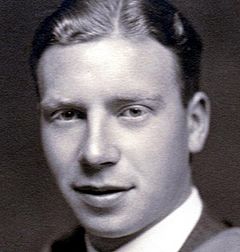Edward H. Simpson facts for kids
Quick facts for kids
Edward Simpson
|
|
|---|---|

Simpson in 1942
|
|
| Born | 10 December 1922 Northern Ireland, UK
|
| Died | 5 February 2019 (aged 96) England, UK
|
| Alma mater | Queen's University Belfast Christ's College, Cambridge |
| Known for | Cryptoanalysis using Banburismus; Simpson's paradox |
| Scientific career | |
| Fields | Mathematics, statistics |
| Institutions | Bletchley Park Civil Service |
| Doctoral advisor | Maurice Bartlett |
Edward Hugh Simpson (born December 10, 1922 – died February 5, 2019) was a smart British man. He was a codebreaker, a statistician (someone who works with data), and worked for the government. He is famous for something called Simpson's paradox, which he described with another person named Udny Yule.
Contents
What is Simpson's Paradox?
Edward Simpson learned about statistics (which is about collecting and understanding data) when he worked as a cryptanalyst (a codebreaker) at Bletchley Park. This was during World War II, from 1942 to 1945.
In 1946, while studying at the University of Cambridge, he wrote an important paper. His teacher, Maurice Bartlett, asked him to publish it later, in 1951. This paper talked about what is now known as the Simpson's paradox.
Simpson's paradox is a tricky situation in statistics. It shows how important it is for statisticians to be careful when they look at data. Sometimes, a trend that appears in different groups of data disappears or even reverses when you combine those groups. It's like a magic trick with numbers! This paradox has even been shown on TV shows like Numb3rs and The Simpsons.
Simpson also made an observation about how teachers' pay changed over time. This was sometimes called "Simpson's Drift."
Edward Simpson's Education
Edward Simpson grew up in Northern Ireland. He went to Coleraine Academical Institution for school. Then, he studied at Queen's University in Belfast. He was very good at math and graduated at age 19 in 1942.
After World War II ended, he continued his studies. From 1945 to 1947, he worked towards a PhD degree in Mathematical Statistics at Christ's College, Cambridge.
His Career and Work
In 1942, Edward Simpson was asked to work at Bletchley Park. This was a secret place where British codebreakers worked during World War II. He started by breaking Italian naval codes.
When the war with Italy was ending in 1943, he was asked to lead a team working on Japanese naval codes (called JN-25). His work helped the US Navy's code-breaking efforts during the war in the Pacific.
After the war, Simpson started working for the British government. He joined the Ministry of Education in 1947. He also worked in other important government departments, like the Treasury. He even worked as a Private Secretary for a very important government official, Lord Hailsham.
From 1973 to 1982, he was a Deputy Secretary in the Department of Education and Science. In 1976, he received a special honor called the CB for his great work in education. He retired in 1982.
Even after retiring, Simpson stayed involved in education. He was the Chairman of a group that gave awards for school curriculums from 1983 to 1995. He also helped at universities like the University of Birmingham and the University of Warwick. From 1989 to 1999, he was the Chairman of Governors for Dixon's City Technology College in Bradford. He even oversaw the building of this college from scratch! He also helped at Bishop Grosseteste University in Lincoln and received an honorary doctorate degree from them in 1992.
His Published Works
Edward Simpson wrote an article about how to measure diversity. It was published in the science magazine Nature in 1949. His famous paper on "The Interpretation of Interaction in Contingency Tables" was published in the Journal of the Royal Statistical Society in 1951.
When he was 95 years old, Simpson wrote two chapters for a book published in 2017. These chapters were about a special code-breaking process called Banburismus. This process was developed by Alan Turing at Bletchley Park during World War II.
His Family Life
Edward Simpson was the only son of Hugh and Mary Simpson. They lived in Ballymena, in County Antrim. In 1947, he married Rebecca Gibson. She had also worked as a codebreaker at Bletchley Park during World War II, in the same section as Edward. Rebecca passed away in 2012. They had one son and one daughter, and four grandchildren.

